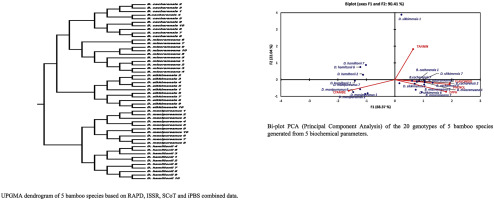当前位置:
X-MOL 学术
›
Phytochemistry
›
论文详情
Our official English website, www.x-mol.net, welcomes your feedback! (Note: you will need to create a separate account there.)
Efficiency of RAPD, ISSR, iPBS, SCoT and phytochemical markers in the genetic relationship study of five native and economical important bamboos of North-East India
Phytochemistry ( IF 3.8 ) Pub Date : 2020-06-01 , DOI: 10.1016/j.phytochem.2020.112330 Thoungamba Amom 1 , Leimapokpam Tikendra 1 , Nandeibam Apana 1 , Moirangthem Goutam 1 , Paonam Sonia 1 , Arunkumar Singh Koijam 1 , Angamba Meetei Potshangbam 1 , Hamidur Rahaman 1 , Potshangbam Nongdam 1
Phytochemistry ( IF 3.8 ) Pub Date : 2020-06-01 , DOI: 10.1016/j.phytochem.2020.112330 Thoungamba Amom 1 , Leimapokpam Tikendra 1 , Nandeibam Apana 1 , Moirangthem Goutam 1 , Paonam Sonia 1 , Arunkumar Singh Koijam 1 , Angamba Meetei Potshangbam 1 , Hamidur Rahaman 1 , Potshangbam Nongdam 1
Affiliation

|
10 primers each of random amplified polymorphic DNA (RAPD), inter-simple sequence repeats (ISSR), inter primer binding site (iPBS) and start codon targeted (SCoT) were used to analyze genetic polymorphism and relationship between 50 genotypes of 5 economical important native bamboos (Bambusa cacharensis, B. mizorameana, Dendrocalamus manipureanus, D. hamiltonii and D. sikkimensis) of North-East India. The 40 different primers generated 111, 115, 116 and 138 polymorphic bands for RAPD, ISSR, iPBS and SCoT markers respectively. The comparative analysis of 4 marker systems based on polymorphic information content (PIC), effective multiplex ratio (EMR) and marker index (MI) values showed SCoT to be more informative with higher discriminating power than the other three markers. The correlation value (r) as determined by the Mantel test ranged from 0.60 (SCoT and RAPD) to 0.83 (iPBS and ISSR) indicating a high positive correlation between the markers. The close correspondence between the genetic matrices of RAPD, ISSR, iPBS and SCoT markers revealed the effectiveness of each marker system in determining the genetic relationship between bamboos. UPGMA (Unweighted Pair Group Arithmetic Mean Method) dendrograms generated from DNA marker analysis demonstrated species-specific clustering of different bamboo genotypes. Except for RAPD, the dendrograms of ISSR, iPBS and SCoT markers also showed a close association of bamboo genotypes based on geographical origin. Principal coordinate analysis (PCoA) revealed the distribution of different bamboo genotypes in accordance with the cluster analysis. The cluster grouping based on phytochemical study not only discriminated the different bamboo species but also illustrated a location-specific grouping of the genotypes. The bamboo clustering pattern derived from phytochemical analysis matched closely with the dendrograms generated by the DNA markers. The present investigation established the possibility of using a combined molecular and phytochemical marker approach to determine the genetic relationship between 5 native bamboos of North-East India with high precision.
中文翻译:

RAPD、ISSR、iPBS、SCoT 和植物化学标记在印度东北部五种本地和经济重要竹子亲缘关系研究中的效率
随机扩增多态性DNA(RAPD)、简单序列间重复序列(ISSR)、引物间结合位点(iPBS)和起始密码子靶向(SCoT)各10个引物,用于分析5个经济重要的50个基因型之间的遗传多态性和关系。印度东北部的原生竹子(Bambusa cacharensis、B. mizorameana、Dendrocalamus manipureanus、D. hamiltonii 和 D. sikkimensis)。40 种不同的引物分别为 RAPD、ISSR、iPBS 和 SCoT 标记生成了 111、115、116 和 138 个多态性条带。基于多态信息含量(PIC)、有效复用率(EMR)和标记指数(MI)值对 4 个标记系统的比较分析表明,SCoT 比其他三个标记具有更高的信息量和更高的辨别力。Mantel 测试确定的相关值 (r) 的范围为 0。60(SCoT 和 RAPD)到 0.83(iPBS 和 ISSR),表明标记之间存在高度正相关。RAPD、ISSR、iPBS和SCoT标记的遗传矩阵之间的密切对应揭示了每个标记系统在确定竹子之间的遗传关系方面的有效性。从 DNA 标记分析生成的 UPGMA(未加权对组算术平均法)树状图证明了不同竹子基因型的物种特异性聚类。除了 RAPD,ISSR、iPBS 和 SCoT 标记的树状图也显示出基于地理起源的竹基因型的密切关联。主坐标分析(PCoA)根据聚类分析揭示了不同竹子基因型的分布。基于植物化学研究的聚类分组不仅区分了不同的竹种,而且还说明了基因型的特定位置分组。来自植物化学分析的竹子聚类模式与 DNA 标记生成的树状图密切匹配。目前的调查确定了使用组合分子和植物化学标记方法来高精度确定印度东北部 5 种本地竹子之间的遗传关系的可能性。
更新日期:2020-06-01
中文翻译:

RAPD、ISSR、iPBS、SCoT 和植物化学标记在印度东北部五种本地和经济重要竹子亲缘关系研究中的效率
随机扩增多态性DNA(RAPD)、简单序列间重复序列(ISSR)、引物间结合位点(iPBS)和起始密码子靶向(SCoT)各10个引物,用于分析5个经济重要的50个基因型之间的遗传多态性和关系。印度东北部的原生竹子(Bambusa cacharensis、B. mizorameana、Dendrocalamus manipureanus、D. hamiltonii 和 D. sikkimensis)。40 种不同的引物分别为 RAPD、ISSR、iPBS 和 SCoT 标记生成了 111、115、116 和 138 个多态性条带。基于多态信息含量(PIC)、有效复用率(EMR)和标记指数(MI)值对 4 个标记系统的比较分析表明,SCoT 比其他三个标记具有更高的信息量和更高的辨别力。Mantel 测试确定的相关值 (r) 的范围为 0。60(SCoT 和 RAPD)到 0.83(iPBS 和 ISSR),表明标记之间存在高度正相关。RAPD、ISSR、iPBS和SCoT标记的遗传矩阵之间的密切对应揭示了每个标记系统在确定竹子之间的遗传关系方面的有效性。从 DNA 标记分析生成的 UPGMA(未加权对组算术平均法)树状图证明了不同竹子基因型的物种特异性聚类。除了 RAPD,ISSR、iPBS 和 SCoT 标记的树状图也显示出基于地理起源的竹基因型的密切关联。主坐标分析(PCoA)根据聚类分析揭示了不同竹子基因型的分布。基于植物化学研究的聚类分组不仅区分了不同的竹种,而且还说明了基因型的特定位置分组。来自植物化学分析的竹子聚类模式与 DNA 标记生成的树状图密切匹配。目前的调查确定了使用组合分子和植物化学标记方法来高精度确定印度东北部 5 种本地竹子之间的遗传关系的可能性。



























 京公网安备 11010802027423号
京公网安备 11010802027423号